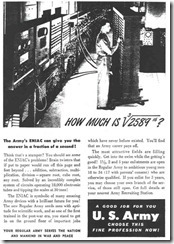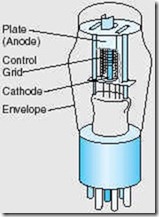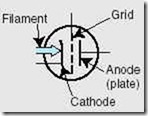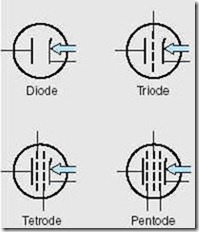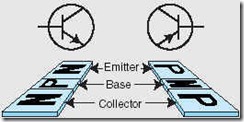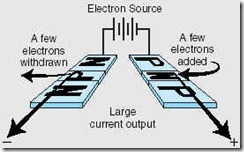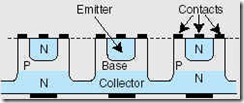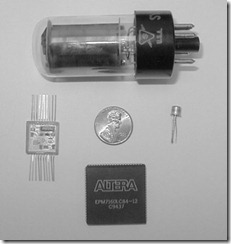1.5 Historical Development
During their 50-year life span, computers have become the perfect example of modern convenience. Living memory is strained to recall the days of steno pools, carbon paper, and mimeograph machines. It sometimes seems that these magical computing machines were developed instantaneously in the form that we now know them. But the developmental path of computers is paved with accidental discovery, commercial coercion, and whimsical fancy. And occasionally computers have even improved through the application of solid engineering practices! Despite all of the twists, turns, and technological dead ends, computers have evolved at a pace that defies comprehension. We can fully appreciate where we are today only when we have seen where we’ve come from.
In the sections that follow, we divide the evolution of computers into generations, each generation being defined by the technology used to build the machine. We have provided approximate dates for each generation for reference purposes only. You will find little agreement among experts as to the exact starting and ending times of each technological epoch.
Every invention reflects the time in which it was made, so one might wonder whether it would have been called a computer if it had been invented in the late 1990s. How much computation do we actually see pouring from the mysterious boxes perched on or beside our desks? Until recently, computers served us only by performing mind-bending mathematical manipulations. No longer limited to white-jacketed scientists, today’s computers help us to write documents, keep in touch with loved ones across the globe, and do our shopping chores. Modern business computers spend only a minuscule part of their time performing accounting calculations. Their main purpose is to provide users with a bounty of strategic information for competitive advantage. Has the word computer now become a misnomer? An anachronism? What, then, should we call them, if not computers?
We cannot present the complete history of computing in a few pages. Entire books have been written on this subject and even they leave their readers wanting for more detail. If we have piqued your interest, we refer you to look at some of the books cited in the list of references at the end of this chapter.
1.5.1 Generation Zero — Mechanical Calculating Machines (1642–1945)
Prior to the 1500s, a typical European businessperson used an abacus for calculations and recorded the result of his ciphering in Roman numerals. After the decimal numbering system finally replaced Roman numerals, a number of people invented devices to make decimal calculations even faster and more accurate. Wilhelm Schickard (1592–1635) has been credited with the invention of the first mechanical calculator, the Calculating Clock (exact date unknown). This device was able to add and subtract numbers containing as many as six digits. In 1642, Blaise Pascal (1623–1662) developed a mechanical calculator called the Pascaline to help his father with his tax work. The Pascaline could do addition with carry and subtraction. It was probably the first mechanical adding device actually used for a practical purpose. In fact, the Pascaline was so well conceived that its basic design was still being used at the beginning of the twentieth century, as evidenced by the Lightning Portable Adder in 1908, and the Addometer in 1920. Gottfried Wilhelm von Leibniz (1646–1716), a noted mathematician, invented a calculator known as the Stepped Reckoner that could add, subtract, multiply, and divide. None of these devices could be programmed or had memory. They required manual intervention throughout each step of their calculations.
Although machines like the Pascaline were used into the twentieth century, new calculator designs began to emerge in the nineteenth century. One of the most ambitious of these new designs was the Difference Engine by Charles Babbage (1791–1871). Some people refer to Babbage as “the father of computing.” By all accounts, he was an eccentric genius who brought us, among other things, the skeleton key and the “cow catcher,” a device intended to push cows and other movable obstructions out of the way of locomotives.
Babbage built his Difference Engine in 1822. The Difference Engine got its name because it used a calculating technique called the method of differences. The machine was designed to mechanize the solution of polynomial functions and was actually a calculator, not a computer. Babbage also designed a general-purpose machine in 1833 called the Analytical Engine. Although Babbage died before he could build it, the Analytical Engine was designed to be more versatile than his earlier Difference Engine. The Analytical Engine would have been capable of performing any mathematical operation. The Analytical Engine included many of the components associated with modern computers: an arithmetic processing unit to perform calculations (Babbage referred to this as the mill), a memory (the store), and input and output devices. Babbage also included a conditional branching operation where the next instruction to be performed was determined by the result of the previous operation. Ada, Countess of Lovelace and daughter of poet Lord Byron, suggested that Babbage write a plan for how the machine would calculate numbers. This is regarded as the first computer program, and Ada is considered to be the first computer programmer. It is also rumored that she suggested the use of the binary number system rather than the decimal number system to store data.
A perennial problem facing machine designers has been how to get data into the machine. Babbage designed the Analytical Engine to use a type of punched card for input and programming. Using cards to control the behavior of a machine did not originate with Babbage, but with one of his friends, Joseph-Marie Jacquard (1752–1834). In 1801, Jacquard invented a programmable weaving loom that could produce intricate patterns in cloth. Jacquard gave Babbage a tapestry that had been woven on this loom using more than 10,000 punched cards. To Babbage, it seemed only natural that if a loom could be controlled by cards, then his Analytical Engine could be as well. Ada expressed her delight with this idea, writing, “[T]he Analytical Engine weaves algebraical patterns just as the Jacquard loom weaves flowers and leaves.”
The punched card proved to be the most enduring means of providing input to a computer system. Keyed data input had to wait until fundamental changes were made in how calculating machines were constructed. In the latter half of the nineteenth century, most machines used wheeled mechanisms, which were difficult to integrate with early keyboards because they were levered devices. But levered devices could easily punch cards and wheeled devices could easily read them. So a number of devices were invented to encode and then “tabulate” card-punched data. The most important of the late-nineteenth-century tabulating machines was the one invented by Herman Hollerith (1860–1929). Hollerith’s machine was used for encoding and compiling 1890 census data. This census was completed in record time, thus boosting Hollerith’s finances and the reputation of his invention. Hollerith later founded the company that would become IBM. His 80-column punched card, the Hollerith card, was a staple of automated data processing for over 50 years.
1.5.2 The First Generation — Vacuum Tube Computers (1945–1953)
Although Babbage is often called the “father of computing,” his machines were mechanical, not electrical or electronic. In the 1930s, Konrad Zuse (1910–1995) picked up where Babbage left off, adding electrical technology and other improvements to Babbage’s design. Zuse’s computer, the Z1, used electromechanical relays instead of Babbage’s hand-cranked gears. The Z1 was programmable and had a memory, an arithmetic unit, and a control unit. Because money and resources were scarce in wartime Germany, Zuse used discarded movie film instead of punched cards for input. Although his machine was designed to use vacuum tubes, Zuse, who was building his machine on his own, could not afford the tubes. Thus, the Z1 correctly belongs in the first generation, although it had no tubes.
Zuse built the Z1 in his parents’ Berlin living room while Germany was at war with most of Europe. Fortunately, he couldn’t convince the Nazis to buy his machine. They did not realize the tactical advantage such a device would give them. Allied bombs destroyed all three of Zuse’s first systems, the Z1, Z2, and Z3. Zuse’s impressive machines could not be refined until after the war and ended up being another “evolutionary dead end” in the history of computers.
Digital computers, as we know them today, are the outcome of work done by a number of people in the 1930s and 1940s. Pascal’s basic mechanical calculator was designed and modified simultaneously by many people; the same can be said of the modern electronic computer. Notwithstanding the continual arguments about who was first with what, three people clearly stand out as the inventors of modern computers: John Atanasoff, John Mauchly, and J. Presper Eckert.
John Atanasoff (1904–1995) has been credited with the construction of the first completely electronic computer. The Atanasoff Berry Computer (ABC) was a binary machine built from vacuum tubes. Because this system was built specifically to solve systems of linear equations, we cannot call it a general-purpose computer. There were, however, some features that the ABC had in common with the general-purpose ENIAC (Electronic Numerical Integrator and Computer), which was invented a few years later. These common features caused considerable controversy as to who should be given the credit (and patent rights) for the invention of the electronic digital computer. (The interested reader can find more details on a rather lengthy lawsuit involving Atanasoff and the ABC in Mollenhoff [1988].)
John Mauchly (1907–1980) and J. Presper Eckert (1929–1995) were the two principle inventors of the ENIAC, introduced to the public in 1946. The ENIAC is recognized as the first all-electronic, general-purpose digital computer. This machine used 17,468 vacuum tubes, occupied 1,800 square feet of floor space, weighed 30 tons, and consumed 174 kilowatts of power. The ENIAC had a memory capacity of about 1,000 information bits (about 20 10-digit decimal numbers) and used punched cards to store data.
John Mauchly’s vision for an electronic calculating machine was born from his lifelong interest in predicting the weather mathematically. While a professor of physics at Ursinus College near Philadelphia, Mauchly engaged dozens of adding machines and student operators to crunch mounds of data that he believed would reveal mathematical relationships behind weather patterns. He felt that if he could have only a little more computational power, he could reach the goal that seemed just beyond his grasp. Pursuant to the Allied war effort, and with ulterior motives to learn about electronic computation, Mauchly volunteered for a crash course in electrical engineering at the University of Pennsylvania’s Moore School of Engineering. Upon completion of this program, Mauchly accepted a teaching position at the Moore School, where he taught a brilliant young student, J. Presper Eckert. Mauchly and Eckert found a mutual interest in building an electronic calculating device. In order to secure the funding they needed to build their machine, they wrote a formal proposal for review by the school. They portrayed their machine as conservatively as they could, billing it as an “automatic calculator.” Although they probably knew that computers would be able to function most efficiently using the binary numbering system, Mauchly and Eckert designed their system to use base 10 numbers, in keeping with the appearance of building a huge electronic adding machine. The university rejected Mauchly and Eckert’s proposal. Fortunately, the United States Army was more interested.
During World War II, the army had an insatiable need for calculating the trajectories of its new ballistic armaments. Thousands of human “computers” were engaged around the clock cranking through the arithmetic required for these firing tables. Realizing that an electronic device could shorten ballistic table calculation from days to minutes, the army funded the ENIAC. And the ENIAC did indeed shorten the time to calculate a table from 20 hours to 30 seconds. Unfortunately, the machine wasn’t ready before the end of the war. But the ENIAC had shown that vacuum tube computers were fast and feasible. During the next decade, vacuum tube systems continued to improve and were commercially successful.
What Is a Vacuum Tube?
The wired world that we know today was born from the invention of a single electronic device called a vacuum tube by Americans and—more accurately—a valve by the British. Vacuum tubes should be called valves because they control the flow of electrons in electrical systems in much the same way as valves control the flow of water in a plumbing system. In fact, some mid-twentieth-century breeds of these electron tubes contain no vacuum at all, but are filled with conductive gasses, such as mercury vapor, which can provide desirable electrical behavior.
The electrical phenomenon that makes tubes work was discovered by Thomas A. Edison in 1883 while he was trying to find ways to keep the filaments of his light bulbs from burning away (or oxidizing) a few minutes after electrical current was applied. Edison reasoned correctly that one way to prevent filament oxidation would be to place the filament in a vacuum. Edison didn’t immediately understand that air not only supports combustion, but also is a good insulator. When he energized the electrodes holding a new tungsten filament, the filament soon became hot and burned out as the others had before it. This time, however, Edison noticed that electricity continued to flow from the warmed negative terminal to the cool positive terminal within the light bulb. In 1911, Owen Willans Richardson analyzed this behavior. He concluded that when a negatively charged filament was heated, electrons “boiled off” as water molecules can be boiled to create steam. He aptly named this phenomenon thermionic emission.
Thermionic emission, as Edison had documented it, was thought by many to be only an electrical curiosity. But in 1905 a British former assistant to Edison, John A. Fleming, saw Edison’s discovery as much more than a novelty. He knew that thermionic emission supported the flow of electrons in only one direction: from the negatively charged cathode to the positively charged anode, also called a plate. He realized that this behavior could rectify alternating current. That is, it could change alternating current into the direct current that was essential for the proper operation of telegraph equipment. Fleming used his ideas to invent an electronic valve later called a diode tube or rectifier.
The diode was well suited for changing alternating current into direct current, but the greatest power of the electron tube was yet to be discovered. In 1907, an American named Lee DeForest added a third element, called a control grid. The control grid, when carrying a negative charge, can reduce or prevent electron flow from the cathode to the anode of a diode.
When DeForest patented his device, he called it an audion tube. It was later known as a triode. The schematic symbol for the triode is shown at the left.
A triode can act either as a switch or as an amplifier. Small changes in the charge of the control grid can cause much larger changes in the flow of electrons between the cathode and the anode. Therefore, a weak signal applied to the grid results in a much stronger signal at the plate output. A sufficiently large negative charge applied to the grid stops all electrons from leaving the cathode.
Additional control grids were eventually added to the triode to allow more exact control of the electron flow. Tubes with two grids (four elements) are called tetrodes; tubes with three grids are called pentodes. Triodes and pentodes were the tubes most commonly used in communications and computer applications. Often, two or three triodes or pentodes would be combined within one envelope so that they could share a single heater, thereby reducing the power consumption of a particular device. These latter-day devices were called “miniature” tubes because many were about 2 inches (5cm) high and one-half inch (1.5cm) in diameter. Equivalent full-sized diodes, triodes, and pentodes were just a little smaller than a household light bulb.
Vacuum tubes were not well suited for building computers. Even the simplest vacuum tube computer system required thousands of tubes. Enormous amounts of electrical power were required to heat the cathodes of these devices. To prevent a meltdown, this heat had to be removed from the system as quickly as possible. Power consumption and heat dissipation could be reduced by running the cathode heaters at lower voltages, but this reduced the already slow switching speed of the tube. Despite their limitations and power consumption, vacuum tube computer systems, both analog and digital, served their purpose for many years and are the architectural foundation for all modern computer systems.
Although decades have passed since the last vacuum tube computer was manufactured, vacuum tubes are still used in audio amplifiers. These “high-end” amplifiers are favored by musicians who believe that tubes provide a resonant and pleasing sound unattainable by solid-state devices.
1.5.3 The Second Generation — Transistorized Computers (1954–1965)
The vacuum tube technology of the first generation was not very dependable. In fact, some ENIAC detractors believed that the system would never run because the tubes would burn out faster than they could be replaced. Although system reliability wasn’t as bad as the doomsayers predicted, vacuum tube systems often experienced more downtime than uptime.
In 1948, three researchers with Bell Laboratories—John Bardeen, Walter Brattain, and William Shockley—invented the transistor. This new technology not only revolutionized devices such as televisions and radios, but also pushed the computer industry into a new generation. Because transistors consume less power than vacuum tubes, are smaller, and work more reliably, the circuitry in computers consequently became smaller and more reliable. Despite using transistors, computers of this generation were still bulky and quite costly. Typically only universities, governments, and large businesses could justify the expense. Nevertheless, a plethora of computer makers emerged in this generation; IBM, Digital Equipment Corporation (DEC), and Univac (now Unisys) dominated the industry. IBM marketed the 7094 for scientific applications and the 1401 for business applications. DEC was busy manufacturing the PDP-1. A company founded (but soon sold) by Mauchly and Eckert built the Univac systems. The most successful Unisys systems of this generation belonged to its 1100 series. Another company, Control Data Corporation (CDC), under the supervision of Seymour Cray, built the CDC 6600, the world’s first supercomputer. The $10 million CDC 6600 could perform 10 million instructions per second, used 60-bit words, and had an astounding 128 kilowords of main memory.
What Is a Transistor?
The transistor, short for transfer resistor, is the solid-state version of the triode. There is no such thing as a solid-state version of the tetrode or pentode. Because electrons are better behaved in a solid medium than in the open void of a vacuum tube, they need no extra controlling grids. Either germanium or silicon can be the basic “solid” used in these solid state devices. In their pure form, neither of these elements is a good conductor of electricity. But when they are combined with trace amounts of elements that are their neighbors in the Periodic Chart of the Elements, they conduct electricity in an effective and easily controlled manner.
Boron, aluminum, and gallium can be found to the left of silicon and germanium on the Periodic Chart. Because they lie to the left of silicon and germanium, they have one less electron in their outer electron shell, or valence. So if you add a small amount of aluminum to silicon, the silicon ends up with a slight imbalance in its outer electron shell, and therefore attracts electrons from any pole that has a negative potential (an excess of electrons). When modified (or doped) in this way, silicon or germanium becomes a P-type material.
Similarly, if we add a little boron, arsenic, or gallium to silicon, we’ll have extra electrons in valences of the silicon crystals. This gives us an N-type material. A small amount of current will flow through the N-type material if we provide the loosely bound electrons in the N-type material with a place to go. In other words, if we apply a positive potential to N-type material, electrons will flow from the negative pole to the positive pole. If the poles are reversed, that is, if we apply a negative potential to the N-type material and a positive potential to the P-type material, no current will flow. This means that we can make a solid-state diode from a simple junction of N and P-type materials.
The solid-state triode, the transistor, consists of three layers of semiconductor material. Either a slice of P-type material is sandwiched between two N-type materials, or a slice of N-type material is sandwiched between two P-type materials. The former is called an NPN transistor, the latter a PNP transistor. The inner layer of the transistor is called the base; the other two layers are called the collector and emitter.
The figure to the left shows how current flows through NPN and PNP transistors. The base in a transistor works just like the control grid in a triode tube: Small changes in the current at the base of a transistor result in a large electron flow from the emitter to the collector.
A discrete-component transistor is shown in “TO-50” packaging in the figure at the beginning of this sidebar. There are only three wires (leads) that connect the base, emitter, and collector of the transistor to the rest of the circuit. Transistors are not only smaller than vacuum tubes, but they also run cooler and are much more reliable. Vacuum tube filaments, like light bulb filaments, run hot and eventually burn out. Computers using transistorized components will naturally be smaller and run cooler than their vacuum tube predecessors. The ultimate miniaturization, however, is not realized by replacing individual triodes with discrete transistors, but in shrinking entire circuits onto one piece of silicon.
Integrated circuits, or chips, contain hundreds to millions of microscopic transistors. Several different techniques are used to manufacture integrated circuits. One of the simplest methods involves creating a circuit using computer-aided design software that can print large maps of each of the several silicon layers forming the chip. Each map is used like a photographic negative where light-induced changes in a photoresistive substance on the chip’s surface produce the delicate patterns of the circuit when the silicon chip is immersed in a chemical that washes away the exposed areas of the silicon. This technique is called photomicrolithography. After the etching is completed, a layer of N-type or P-type material is deposited on the bumpy surface of the chip. This layer is then treated with a photoresistive substance, exposed to light, and etched as was the layer before it. This process continues until all of the layers have been etched. The resulting peaks and valleys of P and N-material form microscopic electronic components, including transistors, that behave just like larger versions fashioned from discrete components, except that they run a lot faster and consume a small fraction of the power.
1.5.4 The Third Generation: Integrated Circuit Computers (1965–1980)
The real explosion in computer use came with the integrated circuit generation. Jack Kilby invented the integrated circuit (IC) or microchip, made of germanium. Six months later, Robert Noyce (who had also been working on integrated circuit design) created a similar device using silicon instead of germanium. This is the silicon chip upon which the computer industry was built. Early ICs allowed dozens of transistors to exist on a single silicon chip that was smaller than a single “discrete component” transistor. Computers became faster, smaller, and cheaper, bringing huge gains in processing power. The IBM System/360 family of computers was among the first commercially available systems to be built entirely of solid-state components. The 360 product line was also IBM’s first offering where all of the machines in the family were compatible, meaning they all used the same assembly language. Users of smaller machines could upgrade to larger systems without rewriting all of their software. This was a revolutionary new concept at the time.
The IC generation also saw the introduction of time-sharing and multiprogramming (the ability for more than one person to use the computer at a time). Multiprogramming, in turn, necessitated the introduction of new operating systems for these computers. Time-sharing minicomputers such as DEC’s PDP-8 and PDP-11 made computing affordable to smaller businesses and more universities.
Comparison of Computer Components
Clockwise, starting from the top:
1) Vacuum Tube
2) Transistor
3) Chip containing 3200 2-input NAND gates
4) Integrated circuit package (the small silver square in the lower left-hand corner is an integrated circuit)
Courtesy of Linda Null
IC technology also allowed for the development of more powerful supercomputers. Seymour Cray took what he had learned while building the CDC 6600 and started his own company, the Cray Research Corporation. This company produced a number of supercomputers, starting with the $8.8 million Cray-1, in 1976. The Cray-1, in stark contrast to the CDC 6600, could execute over 160 million instructions per second and could support 8 megabytes of memory.
1.5.5 The Fourth Generation — VLSI Computers (1980–????)
In the third generation of electronic evolution, multiple transistors were integrated onto one chip. As manufacturing techniques and chip technologies advanced, increasing numbers of transistors were packed onto one chip. There are now various levels of integration: SSI (small scale integration), in which there are 10 to 100 components per chip; MSI (medium scale integration), in which there are 100 to 1,000 components per chip; LSI (large scale integration), in which there are 1,000 to 10,000 components per chip; and finally, VLSI (very large scale integration), in which there are more than 10,000 components per chip. This last level, VLSI, marks the beginning of the fourth generation of computers.
To give some perspective to these numbers, consider the ENIAC-on-a-chip project. In 1997, to commemorate the fiftieth anniversary of its first public demonstration, a group of students at the University of Pennsylvania constructed a single-chip equivalent of the ENIAC. The 1,800 square-foot, 30-ton beast that devoured 174 kilowatts of power the minute it was turned on had been reproduced on a chip the size of a thumbnail. This chip contained approximately 174,569 transistors—an order of magnitude fewer than the number of components typically placed on the same amount of silicon in the late 1990s.
VLSI allowed Intel, in 1971, to create the world’s first microprocessor, the 4004, which was a fully functional, 4-bit system that ran at 108KHz. Intel also introduced the random access memory (RAM) chip, accommodating four kilobits of memory on a single chip. This allowed computers of the fourth generation to become smaller and faster than their solid-state predecessors.
VLSI technology, and its incredible shrinking circuits, spawned the development of microcomputers. These systems were small enough and inexpensive enough to make computers available and affordable to the general public. The premiere microcomputer was the Altair 8800, released in 1975 by the Micro Instrumentation and Telemetry (MITS) corporation. The Altair 8800 was soon followed by the Apple I and Apple II, and Commodore’s PET and Vic 20. Finally, in 1981, IBM introduced its PC (Personal Computer).
The Personal Computer was IBM’s third attempt at producing an “entry-level” computer system. Its Datamaster as well as its 5100 Series desktop computers flopped miserably in the marketplace. Despite these early failures, IBM’s John Opel convinced his management to try again. He suggested forming a fairly autonomous “independent business unit” in Boca Raton, Florida, far from IBM’s headquarters in Armonk, New York. Opel picked Don Estridge, an energetic and capable engineer, to champion the development of the new system, code-named the Acorn. In light of IBM’s past failures in the small-systems area, corporate management held tight rein on the Acorn’s timeline and finances. Opel could get his project off of the ground only after promising to deliver it within a year, a seemingly impossible feat.
Estridge knew that the only way that he could deliver the PC within the wildly optimistic 12-month schedule would be to break with IBM convention and use as many “off-the-shelf” parts as possible. Thus, from the outset, the IBM PC was conceived with an “open” architecture. Although some people at IBM may have later regretted the decision to keep the architecture of the PC as nonproprietary as possible, it was this very openness that allowed IBM to set the standard for the industry. While IBM’s competitors were busy suing companies for copying their system designs, PC clones proliferated. Before long, the price of “IBM-compatible” microcomputers came within reach for just about every small business. Also, thanks to the clone makers, large numbers of these systems soon began finding true “personal use” in people’s homes.
IBM eventually lost its microcomputer market dominance, but the genie was out of the bottle. For better or worse, the IBM architecture continues to be the de facto standard for microcomputing, with each year heralding bigger and faster systems. Today, the average desktop computer has many times the computational power of the mainframes of the 1960s.
Since the 1960s, mainframe computers have seen stunning improvements in price-performance ratios owing to VLSI technology. Although the IBM System/360 was an entirely solid-state system, it was still a water-cooled, power-gobbling behemoth. It could perform only about 50,000 instructions per second and supported only 16 megabytes of memory (while usually having kilobytes of physical memory installed). These systems were so costly that only the largest businesses and universities could afford to own or lease one. Today’s mainframes—now called “enterprise servers”—are still priced in the millions of dollars, but their processing capabilities have grown several thousand times over, passing the billion-instructions-per-second mark in the late 1990s. These systems, often used as Web servers, routinely support hundreds of thousands of transactions per minute!
The processing power brought by VLSI to supercomputers defies comprehension. The first supercomputer, the CDC 6600, could perform 10 million instructions per second, and had 128 kilobytes of main memory. By contrast, supercomputers of today contain thousands of processors, can address terabytes of memory, and will soon be able to perform a quadrillion instructions per second.
What technology will mark the beginning of the fifth generation? Some say that the fifth generation will mark the acceptance of parallel processing and the use of networks and single-user workstations. Many people believe we have already crossed into this generation. Some people characterize the fifth generation as being the generation of neural network, DNA, or optical computing systems. It’s possible that we won’t be able to define the fifth generation until we have advanced into the sixth or seventh generation, and whatever those eras will bring.
1.5.6 Moore’s Law
So where does it end? How small can we make transistors? How densely can we pack chips? No one can say for sure. Every year, scientists continue to thwart prognosticators’ attempts to define the limits of integration. In fact, more than one skeptic raised an eyebrow when, in 1965, Intel founder Gordon Moore stated, “The density of transistors in an integrated circuit will double every year.” The current version of this prediction is usually conveyed as “the density of silicon chips doubles every 18 months.” This assertion has become known as Moore’s Law. Moore intended this postulate to hold for only 10 years. However, advances in chip manufacturing processes have allowed this law to hold for almost 40 years (and many believe it will continue to hold well into the 2010s).
Yet, using current technology, Moore’s Law cannot hold forever. There are physical and financial limitations that must ultimately come into play. At the current rate of miniaturization, it would take about 500 years to put the entire solar system on a chip! Clearly, the limit lies somewhere between here and there. Cost may be the ultimate constraint. Rock’s Law, proposed by early Intel capitalist Arthur Rock, is a corollary to Moore’s law: “The cost of capital equipment to build semiconductors will double every four years.” Rock’s Law arises from the observations of a financier who has seen the price tag of new chip facilities escalate from about $12,000 in 1968 to $12 million in the late 1990s. At this rate, by the year 2035, not only will the size of a memory element be smaller than an atom, but it would also require the entire wealth of the world to build a single chip! So even if we continue to make chips smaller and faster, the ultimate question may be whether we can afford to build them.
Certainly, if Moore’s Law is to hold, Rock’s Law must fall. It is evident that for these two things to happen, computers must shift to a radically different technology. Research into new computing paradigms has been proceeding in earnest during the last half decade. Laboratory prototypes fashioned around organic computing, superconducting, molecular physics, and quantum computing have been demonstrated. Quantum computers, which leverage the vagaries of quantum mechanics to solve computational problems, are particularly exciting. Not only would quantum systems compute exponentially faster than any previously used method, they would also revolutionize the way in which we define computational problems. Problems that today are considered ludicrously infeasible could be well within the grasp of the next generation’s schoolchildren. These schoolchildren may, in fact, chuckle at our “primitive” systems in the same way that we are tempted to chuckle at the ENIAC.
